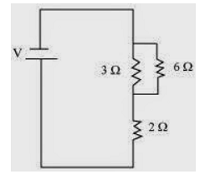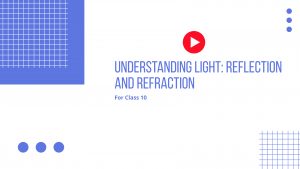NCERT Solutions for Science Class 10 Chapter 12
NCERT Solutions for class-10 Science chapter 12 “Electricity” is curated by senior and experienced teachers of EduAid. Before answering the questions of Chapter 12 , read the theory of the chapter multiple times and get a clear understanding of the concepts included in the chapter.
Here are the answers of the questions included in the NCERT book. Before diving deep into the answers, try to attempt the questions by yourself.
ANSWER THE FOLLOWING QUESTIONS
1. What does an electric circuit mean?
Solution : An electric circuit is a continuous and closed path of an electric current. If the electric circuit complete, current can flow through the circuit.
2. Define the unit of current.
Solution : SI unit of electric current is Ampere. Current is said to be 1 ampere, if 1 coulomb charge flows per second across a cross-section of conductor.
3. Calculate the number of electrons constituting one coulomb of charge.
Solution :
Charge on one electron \(=1.6\times10^{-19}\) coulomb.
No of electron in one coulomb of charge \(= \frac{1}{1.6\times 10^{-19}}\)
\(= 6.25 \times 10^{18}\)
4. Name a device that helps to maintain a potential difference between across a conductor.
Solution : Battery
5. What is meant by saying that the potential difference between two points is \(1\space v\)?
Solution : The potential difference between two points is said to be \(1\) volt, if \(1\) joule of work is to be done for moving charge of \(1\) coulomb from one point to another.
6. How much energy is given to each coulomb of charge passing through a \(6-\) volt battery?
Solution :
Potential difference \((V) = 6\space V\)
Charge \((Q) = 1\space C\)
Energy = total work done \((W) = Q \times V = 1×6 = 6\) joule.
7. On what factor does the resistance of a conductor depend?
Solution : The resistance of a conductor depends upon the following factors:
(a) Length of the conductor
(b) Cross-sectional area of the conductor
(c) Material of the conductor
(d) Temperature of the conductor
8. Will current flow more easily through a thick wire or a thin wire of the same material, when connected to the same source? Why?
Solution : The current flows more easily through a thick wire as compared to thin wire of the same material, when connected to the same source. It is due to the reason that resistance increases with decrease in thickness.
9. Let the resistance of an electric component remains constant while the potential difference across the two ends of the component decreases to half of its former value. What change will occur in the current through it?
Solution : It is given that resistance \(R\) of the electrical component remains constant but the potential difference across the ends of the component decreases to half of its value.
Hence, as per Ohm’s law, new current also decreases to half of its original value.
10. Why are coils of electric toasters and electric irons made of an alloy rather than a pure metal?
Solution : Coils of electric toasters and electric irons are made of an alloy due to the following reasons:
(i.) Resistivity of an alloy is generally higher than that of pure metal.
(ii.) At high temperature, an alloy does not oxidize readily. Hence, coil of an alloy has longer life.
11. Use the data in Table \(12.2\) to answer the following:
(a) Which among iron and mercury is a better conductor?
(b) Which material is the best conductor?
Solution :
(a) Resistivity of iron \(= 10.0×10^{-8}Ω\space m\)
Resistivity of mercury \(=94.0×10^{-8}Ω\space m\)
Resistivity of mercury is more than that of iron. This implies that iron is a better conductor than mercury.
(b) It can be observed from Table \(12.2\) that the resistivity of silver is the lowest among the listed materials. Hence, it is the best conductor.
12. Draw a schematic diagram of a circuit consisting of a battery of three cells of \(2\space V\), each, \(a\space 5\space Ώ\) resistor, \(8 \space Ώ\) resistors and a \(12\space Ώ\) and a plug key, all connected in series.
Solution : The schematic diagram of circuit is as follows:

13. Redraw the circuit of question 1, putting in an ammeter to measure the current through the resistors and a voltmeter to measure the potential difference across the 12 Ώ resistors. What would be the reading in the ammeter and voltmeter?
Solution :

Here ammeter \(A\) has been joined in series of circuit and voltmeter \(V\) is joined in parallel to \(12\) ohms’ resistor.
Total voltage of battery \(V = 3×2 = 6 \space V\).
Total resistance \(R = R_1+ R_2+ R_3 = 5 Ω +8 Ω +12 Ω = 25 Ω\)
Ammeter reading (current) \(= I =\frac{ V}{R} =\frac{ 6}{25} = 0.24\space A\).
Voltmeter reading \(= IR = 0.24 \times 12 = 2.88\space V\).
14. Judge the equivalent resistance when the following are connected in parallel:
(a) \(1 Ω\) and \(10^6 Ω\)
(b) \(1 Ω,\space 10^3 Ω\) and \(10^6\space Ω\)
Solution :
When the resistances are joined in parallel, the resultant resistance in parallel arrangement is given by:
\(\frac{1}{R} =\frac{ 1}{R_1} +\frac{ 1}{R_2}+ \frac{1}{R_3}\)
(a) \(\frac{1}{R} =\frac{ 1}{1}+\frac{ 1}{10^6} = 1+ 10^{-6}\)
\(R = 1 Ω\)
(b) \(\frac{1}{R} = \frac{1}{1} +\frac{1}{10^3} +\frac{ 1}{10^6} = 1 + 10^{-3}+ 10^{-6}\)
\(R= 1 Ω\)
15. An electric lamp of \(100\space Ω\), a toaster of resistance \(50\space Ω\) and a water filter of resistance \(500\space Ω\) are connected in parallel to a \(220\space V\) source. What is the resistance of an electric iron connected to the same source that takes as much current as all three appliances, and what is the current through it?
Solution :
Here, voltage \((V)=220\space V\)
\(R_1=100\space\Omega,\space\space R_2=500\space\Omega\space and\space R_3=500\space\Omega\)
\(\frac{1}{R}=\frac{1}{R_1}+\frac{1}{R_2}+\frac{1}{R_3}\)
\(\frac{1}{R}=\frac{1}{100}+\frac{1}{50}+\frac{1}{500}=\frac{16}{500}\)
\(R=\frac{500}{16}=31.25\space\Omega\)
The resistance of electric iron, which draws as much current as all three appliances take together \(= R = 31.25\space Ω\).
Current passing through electric iron \((I) =\frac{ V}{R} = \frac{220}{31.25} = 7.04\space A\).
16. What are the advantages of connecting electrical devices in parallel with the battery instead of connecting them in series?
Solution : Advantage of connecting electrical devices in parallel with the battery are as follows:
(i) Voltage across each connecting electrical device is same and device take current as per its resistance.
(ii) Separate on/off switches can be applied across each device.
(iii) Total resistance in parallel circuit decreases, hence, a great current may be drawn from cell.
(iv) If one electrical device is damaged; then other devices continue to work properly.
17. How can three resistors of resistance \(2\space Ω,\space 3\space Ω\) and \(6\space Ω\) be connected to give a total resistance of (a) \(4\space Ω\space (b)\space 1\space Ω\)?
Solution :
(a) If we connect resistance of \(3\space Ω\) and \(6\space Ω\) in parallel and then resistance of \(2\space Ω\) is connected in series of the combination, then total resistance of combination is \(4\space Ω\).

(b) If all the three resistance are joined in parallel the resultant resistance will be 1 Ω.

18. What is (a) the highest, (b) the lowest total resistance that can be secured by combination of four resistances of \(4\space Ω,\space 8\space Ω,\space 12\space Ω\) and \(24\space Ω\)?
Solution :
(a) To obtain highest resistance, all the four resistances must be connected in series arrangement. In that case resultant
\(R=R_1+R_2+R_3\)
\(= 4+8+12\space 48\space Ω\)
(b) To obtain lowest resistance, all the four resistance must be connected in parallel arrangement.
\(\frac{1}{R} =\frac{1}{R_1}+\frac{1}{R_2}=\frac{1}{R_3}\)
\(= \frac{1}{4}+\frac{1}{8} +\frac{1}{12} + \frac{1}{24}= \frac{12}{24\space Ω}\)
\(= \frac{24}{12} = 2\space Ω\)
19. Why does the cord of an electric heater not glow while the heating element does?
Solution : Cord of heater and electric heater are joined in series and carry same current when joined to voltage source. As resistance of cord is extremely small as compared to that of heater element. hence, heat produced is extremely small in cord but much larger in heater element. So, the heating element begins to glow but cord does not glow.
20. Compute the heat generated while transferring 96000 coulomb of charge in one hour through a potential difference of 50 V.
Solution :
Charge transferred \((Q) = 96000\space C\), time \(= 1\space hour = 60 \times 60 = 3600\space s\) and potential difference \((V) = 50space V\).
Heat generated \((H) = VIt = V.Q = 50 \times 96000 = 4800000\space j = 4.8\times 10^6\space j\)..
21. An electric iron of resistance \(20\) takes a current of \(5\space A\). Calculate the heat developed in \(30\space s\).
Solution :
Resistance of electric iron \((R) = 20\space Ω\), current \((I) = 5\space A\) and time \(= 30\space s\).
Heat generated \((H) = I^2Rt = 5^2\times20\times30 = 15000\space j\).
22. What determines the rate at which energy is delivered by a current?
Solution : Electric power determines the rate at which energy is delivered by a current.
23. An electric motor takes \(5\space A\) from a \(220\space V\) line. Determine the power of the motor and energy consumed in \(2\space h\).
Solution :
It is given that current drawn by electric motor \((I) = 5\space A\). the line voltage \(V = 220\space V\) time \((t) = 2\space h\).
Power of motor \((P) = P = VI = 220 \times 5 = 1100\space W\) and the energy consumed \((E) = Pt\)
\(1100 W \times 2\space h = 2200 \space Wh\) or \(2.2\space kWh\).
24. A piece of wire of resistance \(R\) is cut into five equal parts. These parts are then connected in parallel. If the equivalent resistance of this combination is \(R’\), then the ratio \(\frac{R}{R’}\) is:
(a) \(\frac{1}{25}\) (b) \(\frac{1}{5}\) (c) \(5\) (d) \(25\)
Solution : (d) \(25\)
25. Which of the following terms does not represent electrical power in a circuit?
(a) \(I^2R\) (b) \(IR^2\) (c) \(VI\) (d) \(\frac{V^2}{R}\)
Solution : (b) \(IR^2\)
26. An electric bulb is rated \(220\space V\) and \(100\space W\). When it is operated on \(110\space V\), the power consumed will be:
(a) \(100\space W\) (b) \(75\space W\) (c) \(50\space W\) (d) \(25\space W\)
Solution : (d) \(25\space W\)
27. Two conducting wires of the same material and of equal lengths and equal diameters are first connected in series and then parallel in a circuit across the same potential difference. The ratio of heat produced in series and parallel combination would be:
(a) \(1:2\) (b) \(2:1\) (c) \(1:4\) (d) \(4:1\)
Solution : (c) \(1:4\)
28. How is a voltmeter connected in the circuit to measure the potential difference between two points?
Solution : A voltmeter is always connected in parallel to resistance across the point between which the potential difference is to be measured.
29. A copper wire has diameter \(0.5\space mm\) and resistivity of \(1.6\times10^{-8}\space m\). what will be the length of this wire to make its resistance \(10\)? How much does the resistance change if the diameter is doubled?
Solution :
Diameter of wire \((d) = 0.5\space mm\)
resistivity \((ρ) 1.6 \times10^{-8}\space Ωm\)
resistance \((R) = 10\space Ω\).
\(R = \frac{ρL}{A}\)
\(L= \frac{πD^2R}{4ρ}\)
\(= \frac{22 \times (5 \times 10^{-4})^2}{ 7 \times 4 \times 1.6 \times10^{-8}} = 122.5\space m\)
If the diameter is doubled for given length of given material resistance is inversely proportional to the cross-section area of wire.
30. The value of current \(I\) flowing in a given resistor for the corresponding values of potential difference \(V\) across the resistor are given below:

Plot a graph between \(V\) and \(I\) and calculate the resistance of that resistor.
Solution : From the given data the \(I-V\) graph is a straight line as shown below:

The slope of the line gives the value of Resistance (\(R\)) as,
Slope \(= \frac{1}{R} =\frac{ BC}{AC} =\frac{ 2}{6.8}\)
\(R =\frac{ 6.8}{2} = 3.4\space Ω\)
Therefore, the resistance of register is \(3.4\spaceΩ\).
31. When a 12 v battery is connected across an unknown resistor, there is a current of 2.5 mA in the circuit. Find the value of the resistance of the resistor.
Solution :
Voltage of battery \(= V = 12\space V\)
Current \((I) = 2.5 \space m\)
\(A = 2.5 \times 10^{-3}\space A\)
Resistance \((R) =\frac{ V}{I} = \frac{12V}{ 2.5 \times 10^{-3}}\space A = 4800\space Ω\).
32. A battery of \(9\space V\) is connected in series with resistance of \(0.2\space Ω\), \(0.3\space Ω\), \(0.4\space Ω\), \(0.5\space Ω\) and \(12\space Ω\) respectively. How much current would flow through the \(12\) resistor?
Solution :
Potential difference \((V) = 9\space V\).
Total resistance \((R) = R_1+ R_1+ R_3+R_4 +R_5\)
\(= 0.2 +0.3 + 0.5 + 0.5 + 12 = 13.4\space Ω\)
Current in the circuit \((I) = \frac{V}{R} = \frac{9\space V}{13. 4\space Ω} = 0.67\space A\).
In series circuit same current flows through all the resistance, hence current of \(0.67\space A\) will flow through \(12\space Ω\) resistor.
33. How many \(176\space Ω\) resistors (in parallel) are required to carry \(5\space A\) on a \(220\space V\) line?
Solution :
Let a resistor of \(176\space Ω\) are joined in parallel. Then their combined resistance (\(R\))
\(\frac{1}{R} = \frac{1}{176} +\frac{ 1}{176}\) times \(= \frac{n}{176}\) or \(R = \frac{176}{n\space Ω}\)
It is given that \(V= 220\space V\) and \(I = 5\space A\)
\(R =\frac{ V}{I}\) or \(\frac{176}{n} = \frac{220}{5} = 44\space Ω\)
\(n =\frac{ 176}{44} = 4, 4\) resistors should be joined in parallel.
34. Show how you would connect three resistors, each of resistance \(6\space Ω\) so that the combination has resistance of (i) \(9\space Ω\) (ii) \(4\space Ω\).
Solution :
It is given here that \(R_1 = R_2= 6\space Ω\).
(i) To get net resistance of \(9\space Ω\) we should join three resistors as below:

(ii) To get \(4\space Ω\) net resistance we should join three resistors as below:

35. Several electric bulbs designed to be used on a \(220\space V\) electric supply line, are rated \(10\space W\). How many lamps can be connected in parallel with each other across the two wires of \(220\space V\) line if the maximum allowable current is \(5\space A\)?
Solution :
Each bulb is rated as \(10\space W,\space 220\space V\), It draws a current \((I) = \frac{P}{V} = \frac{10\space W}{220\space V}\)
\(= \frac{1}{22\space A}\).
As the maximum allowable current is \(5\) A and all lamps are connected in parallel, hence maximum number of bulbs joined in parallel with each other \(= 5\times 22 = 110\).
36. A hot plate of an electric oven connected to a \(220\space V\) line has two resistance coils \(A\) and \(B\). Each of \(24\space Ω\) resistances, which may be used separately, in series or in parallel. What are the currents in the three cases?
Solution :
It is given that potential difference \((V) = 220\space V\).
Resistance of coil \((A) =\) Resistance of coil \((B) = 24\space Ω\)
(i) When either coil is used separately, the circuit \((I) = \frac{V}{R} = \frac{220\space V}{ 24\space Ω}\)
\(= 9.2\space A\).
(ii) When two coils are used in series total resistance \((R)\)
\(= R_1 + R_2 = 24 +24 = 48 \space Ω\)
Current flowing \((I) = \frac{V}{R} =\frac{ 220\space V}{ 48\space Ω} = 4.6\space A\).
(iii) When two coils are joined in parallel. Total resistance \((R) = \frac{1}{24} + \frac{1}{24}\)
\(= \frac{2}{24},\space R = 12\space Ω\).
Current \( (I) = \frac{V}{R}=\frac{ 220\space V}{12\space Ω} = 18.3\space A\).
37. Compare the power used in the \(2\space Ω\) resistor in each of the following circuits:
(i) a \(6-volt\) battery in series with \(1\space Ω\) and \(2\space Ω\) resistors and,
(ii) a \(4\space V\) battery in parallel with \(12\space Ω\) and \(Ω\) resistors.
Solution :
(i) When a \(2\space Ω\) resistor is joined t a \(6\space V\) battery in series with \(1\space Ω\) and \(2\space Ω\) resistors. Total resistance \((R) = 2 + 1 + 2 = 5 \spaceΩ\).
Current \((I) = \frac{6\space V}{5\space Ω} = 1.2\space A\)
Power used in \(2\space A\) resistor \(= I^2R = 2.88\space W\)
(ii) When \(2\space Ω\) resistor is joined to a \(4\space V\) battery in parallel with \(12\space Ω\) resistor and \(2\space Ω\) resistors, the current flowing in \(2\space Ω = \frac{4\space V}{ 2\space Ω} = 2\space A\).
Power used in \(2\space Ω\) resistor \(= I^2R = 8\space W\)
Ratio \(= \frac{2.88}{8} = 0.36: 1\).
38. Two lamps, one rated \(100\space W\) at \(220\space V\), and the other \(60\space W\) at \(220\space V\) are connected in parallel to electric mains supply. What current is drawn from the line if the supply voltage is \(220\space V\)?
Solution :
Current drawn by \(1^{st}\) lamp rated \(100\space W\) at \(220 V = \frac{P}{V} = \frac{100}{220} = \frac{5}{11 A}\).
Current drawn by \(2^{nd}\) lamp rated \(60\space W\) at \(220 V =\frac{ 60}{220} =\frac{3}{11 A}\).
In parallel arrangement the total current \(= I_1+I_2 = \frac{3}{11}+ \frac{5}{11} =\frac{ 8}{11} = 0.73 A\).
39. Which uses more energy, a \(250\space W\) TV set in 1 hour, or a \(1200\space W\) toaster in \(10\) minutes?
Solution :
Energy used by a TV set of power \(250\space W\) in \(1\) hour \(= P \times t = 250\space Wh\).
Energy used by toaster of power \(1200\space W \) in \(10\) minute \((\frac{10}{60\space h}\))
\(= P \times t = 1200\space W \times \frac{10}{60\space h} = 200\space Wh\).
40. An electric heater of resistance \(8\) draws \(15\space A\) from the service mains for \(2\) hours. Calculate the rate at which heat is developed in the heater.
Solution :
Resistance of electric heater \((R) = 8\space Ω\), current \((I) = 15\space A\).
Rate at which heat developed in the heater \(= \frac{I_2Rt}{t} = 15 \times 15 \times 8 = 1800\space W\).
41. Explain the following:
(a) Why is the tungsten used almost exclusively for filament of electric lamps?
(b) Why are the conductors of electric heating devices, such as bread-toasters and electric irons, made of an alloy rather than a pure metal?
(c) Why is the series arrangement not used for domestic circuits?
(d) How does the resistance of wire vary with its area of cross-section?
(e) Why are copper and aluminium wires usually employed for electric transmission?
Solution :
(a) For filament of electric lamp we require a strong metal with high melting point. Tungsten is used exclusively for filament of electric lamps because its melting point is extremely high.
(b) Conductors of electric heating devices are made of an alloy rather than a pure metal due to high resistivity than pure metal and high melting point to avoid getting oxidized at high temperature.
(c) Series arrangement is not used for domestic circuits as current to all appliances remain same in spite of different resistance and every appliance cannot be switched on/ off independently.
(d) Resistance of a wire is inversely proportional to its cross-section area.
(e) Copper and aluminium wires are usually employed for electricity transmission because they are good conductor with low resistivity. They are ductile also to be drawn into thin wires.
Study materials
- Refernce Books
- NCERT Solutions
- Syllabus







